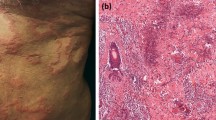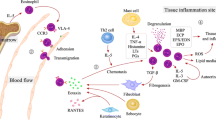Abstract
Eosinophils are seen in a number of dermatologic conditions. While the extent of their function in these diseases remains to be fully elucidated, pathogenic activity in bullous pemphigoid suggests a more significant role than previously thought. Several dermatoses have a fairly characteristic histologic morphology of eosinophil infiltration. We hypothesized that epidermal expression of eotaxins and TSLP would differ by disease, perhaps explaining the different histologic morphologies. We performed a retrospective study of eosinophil rich dermatoses to perform immunohistochemistry. We collected 49 specimens composed of bullous pemphigoid (n = 15), atopic dermatitis (n = 12), drug rash (n = 8), arthropod assault (n = 5), and non-bullous pemphigoid eosinophilic spongiosis (n = 5). We used lichen planus (n = 4) as a control for lymphocyte-mediated inflammation. TSLP was diffusely expressed in all epidermal samples, whereas eotaxins demonstrated a weaker staining. Eotaxins and TSLP demonstrated a gradient between basal and spinous keratinocytes. The correlation between overall basal keratinocyte and spinous keratinocyte staining of eotaxins and TSLP with the number of eosinophils demonstrated a significant correlation between eotaxin-1 (R = 0.404, P = 0.004), eotaxin-2 (R = 0.576, P < 0.001), and eotaxin-3 (R = 0.512, P < 0.001), but not TSLP (R = 0.164, P = 0.251). These remained significant after correcting for multiple comparisons. While we were unable to detect significant differences in epidermal expression of eotaxins and TSLP in various eosinophil rich dermatoses, we identified a significant correlation of spinous keratinocyte eotaxin staining with tissue eosinophilia. Our identification of a correlation of spinous keratinocyte eotaxin staining with tissue eosinophilia may provide insight into local eosinophil chemotaxis.




Similar content being viewed by others
References
Ahmadi Z, Hassanshahi G, Khorramdelazad H et al (2016) An overlook to the characteristics and roles played by eotaxin network in the pathophysiology of food allergies: allergic asthma and atopic dermatitis. Inflammation 39:1253–1267. https://doi.org/10.1007/s10753-016-0303-9
Amber KT, Chernyavsky A, Agnoletti AF et al (2018) Mechanisms of pathogenic effects of eosinophil cationic protein and eosinophil-derived neurotoxin on human keratinocytes. Exp Dermatol 27:1322–1327. https://doi.org/10.1111/exd.13782
Amber KT, Valdebran M, Kridin K, Grando SA (2018) The role of eosinophils in bullous pemphigoid: a developing model of eosinophil pathogenicity in mucocutaneous disease. Front Med 5:201. https://doi.org/10.3389/fmed.2018.00201
Bağcı IS, Horváth ON, Ruzicka T, Sárdy M (2017) Bullous pemphigoid. Autoimmun Rev 16:445–455. https://doi.org/10.1016/j.autrev.2017.03.010
Batia LM, Beattie K, Katibah GE et al (2013) The epithelial cell-derived atopic dermatitis cytokine TSLP activates neurons to induce itch. Cell. https://doi.org/10.1016/j.cell.2013.08.057
Cianferoni A, Spergel J (2014) The importance of TSLP in allergic disease and its role as a potential therapeutic target. Expert Rev Clin Immunol 10:1463–1474
Davoine F, Lacy P (2014) Eosinophil cytokines, chemokines, and growth factors: emerging roles in immunity. Front Immunol 5:570. https://doi.org/10.3389/fimmu.2014.00570
Frezzolini A, Teofoli P, Cianchini G et al (2002) Increased expression of eotaxin and its specific receptor CCR8 in bullous pemphigoid. Eur J Dermatol 12:27–31
Gounni Abdelilah S, Wellemans V, Agouli M et al (2006) Increased expression of Th2-associated chemokines in bullous pemphigoid disease. Role of eosinophils in the production and release of these chemokines. Clin Immunol 120:220–231. https://doi.org/10.1016/j.clim.2006.03.014
Günther C, Wozel G, Dressler J et al (2004) Tissue eosinophilia in pemphigoid gestationis: association with eotaxin and upregulated activation markers on transmigrated eosinophils. Am J Reprod Immunol 51:32–39
Günther C, Wozel G, Meurer M, Pfeiffer C (2011) Up-regulation of CCL11 and CCL26 is associated with activated eosinophils in bullous pemphigoid. Clin Exp Immunol 166:145–153. https://doi.org/10.1111/j.1365-2249.2011.04464.x
Li N, Xiao S, Liu Z et al (2018) BP180 dysfunction triggers spontaneous skin inflammation in mice. Proc Natl Acad Sci. https://doi.org/10.1073/pnas.1721805115
Liu LY, Jarjour NN, Busse WW, Kelly EA (2003) Chemokine receptor expression on human eosinophils from peripheral blood and bronchoalveolar lavage fluid after segmental antigen challenge. J Allergy Clin Immunol 112:556–562
Long H, Zhang G, Wang L, Lu Q (2016) Eosinophilic skin diseases: a comprehensive review. Clin Rev Allergy Immunol 50:189–213
Margolis DJ, Kim B, Apter AJ et al (2014) Thymic stromal lymphopoietin variation, filaggrin loss of function, and the persistence of atopic dermatitis. JAMA Dermatol. https://doi.org/10.1001/jamadermatol.2013.7954
Nakashima H, Fujimoto M, Asashima N et al (2007) Serum chemokine profile in patients with bullous pemphigoid. Br J Dermatol 156:454–459. https://doi.org/10.1111/j.1365-2133.2006.07601.x
Noh JY, Shin JU, Park CO et al (2016) Thymic stromal lymphopoietin regulates eosinophil migration via phosphorylation of L-plastin in atopic dermatitis. Exp Dermatol. https://doi.org/10.1111/exd.13111
Nygaard U, Hvid M, Johansen C et al (2016) TSLP, IL-31, IL-33 and sST2 are new biomarkers in endophenotypic profiling of adult and childhood atopic dermatitis. J Eur Acad Dermatol Venereol. https://doi.org/10.1111/jdv.13679
Sastre B, Rodrigo-Muñoz JM, Garcia-Sanchez DA et al (2018) Eosinophils: old players in a new game. J Investig Allergol Clin Immunol 28:289–304. https://doi.org/10.18176/jiaci.0295
Shinkai A, Yoshisue H, Koike M et al (1999) A novel human CC chemokine, eotaxin-3, which is expressed in IL-4-stimulated vascular endothelial cells, exhibits potent activity toward eosinophils. J Immunol 163:1602–1610
Shrikhande M, Hunziker T, Braathen LR et al (2000) Increased coexpression of eotaxin and interleukin 5 in bullous pemphigoid. Acta Derm Venereol 80:277–280
Tatsuno K, Fujiyama T, Yamaguchi H et al (2015) TSLP directly interacts with skin-homing Th2 cells highly expressing its receptor to enhance IL-4 production in atopic dermatitis. J Invest Dermatol. https://doi.org/10.1038/jid.2015.318
Wakugawa M, Nakamura K, Hino H et al (2000) Elevated levels of eotaxin and interleukin-5 in blister fluid of bullous pemphigoid: correlation with tissue eosinophilia. Br J Dermatol 143:112–116
Wallmeyer L, DIetert K, Sochorová M et al (2017) TSLP is a direct trigger for T cell migration in filaggrin-deficient skin equivalents. Sci Rep. https://doi.org/10.1038/s41598-017-00670-2
Wong CK, Hu S, Cheung PFY, Lam CW (2009) TSLP induces chemotactic and pro-survival effects in eosinophils: implications in allergic inflammation. Am J Respir Cell Mol Biol. https://doi.org/10.1165/rcmb.2009-0168OC
Wong CK, Hu S, Cheung PFY, Lam CWK (2010) Thymic stromal lymphopoietin induces chemotactic and prosurvival effects in eosinophils: implications in allergic inflammation. Am J Respir Cell Mol Biol 43:305–315. https://doi.org/10.1165/rcmb.2009-0168OC
Ying S, Meng Q, Zeibecoglou K et al (1999) Eosinophil chemotactic chemokines (eotaxin, eotaxin-2, RANTES, monocyte chemoattractant protein-3 (MCP-3), and MCP-4), and C–C chemokine receptor 3 expression in bronchial biopsies from atopic and nonatopic (Intrinsic) asthmatics. J Immunol 163:6321–6329
Valdebran M, Kowalski EH, Kneiber D, Li J, Kim J, Amber KT (2019) Digital quantification of epidermal protein expression in paraffin-embedded tissue using immunohistochemistry. Methods Mol Biol. https://doi.org/10.1007/7651_2019_244
Funding
This study was funded in part by a grant from the International Pemphigus and Pemphigoid Foundation (KTA).
Author information
Authors and Affiliations
Corresponding author
Ethics declarations
Conflict of interest
The authors report that they have no potential conflict of interest.
Additional information
Publisher's Note
Springer Nature remains neutral with regard to jurisdictional claims in published maps and institutional affiliations.
Rights and permissions
About this article
Cite this article
Valdebran, M., Kowalski, E.H., Kneiber, D. et al. Epidermal expression of eotaxins and thymic stromal lymphopoietin in eosinophil rich dermatoses. Arch Dermatol Res 311, 705–710 (2019). https://doi.org/10.1007/s00403-019-01954-5
Received:
Accepted:
Published:
Issue Date:
DOI: https://doi.org/10.1007/s00403-019-01954-5




